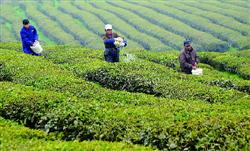Lily planting technology video

First, select the land with higher topography, sunny direction, better drainage and irrigation conditions, deep soil layer and non-continuous cropping in fertility. Before ploughing, 450 kg of organic fertilizer and 150 kg of calcium, magnesium and phosphorus were applied per mu, and then ploughed 25 cm to 30 cm. After the fertilizer rotted, the deep ploughing fine rake was carried out to fully mix the base fertilizer with the soil, improve the soil physical and chemical properties, and create good conditions for the full development of lily root system and bulb expansion. Combined with soil preparation, the width of the border is 1.4 to 1.6 meters, which requires convenient irrigation and drainage. Second, select the bulb lily to plant the vegetative bulb, the bulb can be divided into large, medium and small. Generally, the economic benefit of planting middle bulb with 50-60 grams is the best. When selecting seeds, we should pay attention to: ① selected 3-5 lateral bulbs to prevent species degradation, and ② selected bulbs without brown necrotic plaques to prevent plant loss caused by disease infection. Third, the suitable sowing time for lily should be from late September to early October to early March of the following year. In the southern red soil hilly region, the sowing specification is 40 × 30 cm between rows and plants, ensuring that the population density is more than 6000 plants per mu. Sowing should be ditched while sowing while covering the soil with a thickness of 3 cm to 4 cm. After sowing, the land must be kept dry and there must be no stagnant water. Fourth, strengthen field management 1. During the overwintering period of topdressing and drainage lilies, 20 kg of urea and 30 kg of potassium chloride were used to top up wax fertilizer per mu before freezing, and at the same time, combined with cleaning the drains to cultivate the soil and protect the roots, so as to make the gutters unobstructed, prevent stagnant water in the field and reduce the decay of lilies due to wet damage. Topdressing is applied twice before emergence in spring, with 50 kg of ternary sulfur compound fertilizer or 2.5 kg of sulfur per mu each time. After emergence, cover a layer of grain grass in the field to prevent soil hardening and play the role of moisturizing, fertilizing and cooling at the same time. two。 Using plastic film mulching cultivation to cover lily for 30 days for 40 days in early spring could shorten the emergence period of lily seedlings for 7 days and increase yield by 12%. 3. Timely picking the top of the stem is based on the number of leaves, and it is most suitable to take off the top when the plant has grown more than 60 leaves and the daily average temperature is less than 23 ℃. The results showed that the yield of centering was higher than that of non-coring, and the yield of coring in the suitable period was higher than that in late, and the more leaves were retained in the suitable period, the greater the yield was. 4. To prevent the early withering of green leaves, it is necessary to prolong the life of functional leaves. In the late growth stage of lilies, the bulbs of green leaves are large and the yield is high. For this reason, when bulb expansion slows down in late June, 0.2% potassium dihydrogen phosphate plus 0.3% 0.5% urea is used to apply foliar fertilizer once. 5. Within 1-2 days after sowing for pest control, 50-80 grams of diachlor were sprayed per mu to prevent weeds. During the growth period, the main diseases and insect pests of lily are ground tiger, aphids and virus diseases. At the initial stage of the onset of virus disease, 1.5% Zhixianling emulsion is sprayed 1000 times, or antiviral agent No. 1 is sprayed 1000 times, once every 10 days, continuously for 2 times. After emergence, aphids are sprayed with 1500 times of methamidophos EC, or 40% omethoate can be used to control aphids. In late April, 6-8 kg of carbofuran or 0.5 kg of phoxim per mu were sprinkled with poisonous soil to kill insects underground. Click to get more lily planting techniques click to get more flower planting techniques
- Prev

Rose culture: which rose varieties are suitable for potted plants?
Which rose varieties are suitable for potted plants? Please introduce many kinds of rose, which can be divided into hybrid perfume rose, rattan rose, miniature rose and shrub rose. The growth and development habits of different varieties of rose are different. Some potted plants perform well, while others do not have roots or branches and leaves, but they do not bloom frequently and are sleepy in plastic surgery.
- Next

Tea planting techniques: how to fertilize the tea garden?
How to fertilize the tea garden? Please introduce the method of tea garden can refer to the following methods of topdressing: 1, as topdressing in early spring, using nitro compound fertilizer as topdressing during mining has a quick effect and a remarkable effect. Compared with urea, it takes 7 to 10 days to take effect after urea is spread, the nutrition is single and easy to form.
Related
- Fuxing push coffee new agricultural production and marketing class: lack of small-scale processing plants
- Jujube rice field leisure farm deep ploughing Yilan for five years to create a space for organic food and play
- Nongyu Farm-A trial of organic papaya for brave women with advanced technology
- Four points for attention in the prevention and control of diseases and insect pests of edible fungi
- How to add nutrient solution to Edible Fungi
- Is there any good way to control edible fungus mites?
- Open Inoculation Technology of Edible Fungi
- Is there any clever way to use fertilizer for edible fungus in winter?
- What agents are used to kill the pathogens of edible fungi in the mushroom shed?
- Rapid drying of Edible Fungi

